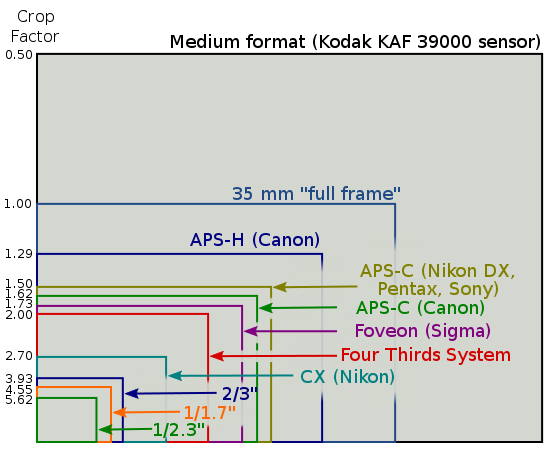What are the Differences?
APS-C vs. Full-frame
Which format is best for you?
In the world of photography, various types of cameras are available to capture stunning images. Two popular options often come up in discussions are mirrorless and DSLR cameras. Both have unique features and advantages and understanding the differences can help you make an informed decision when choosing the right camera for your needs. This article will explore the disparities between mirrorless and DSLR cameras, shedding light on their key characteristics, functionalities, and benefits.

APS-C
APS-C, short for Advanced Photo System type-C, refers to a type of camera sensor size commonly found in entry-level and mid-range DSLRs and mirrorless cameras. The APS-C sensor is smaller than a full-frame sensor, typically measuring around 22.2 x 14.8mm. This smaller size results in a crop factor, which affects the field of view and depth of field.
Full-frame
Full-frame is a camera sensor size equivalent to the traditional 35mm film frame. Full-frame sensors offer a larger surface area, typically around 36 x 24mm. This larger sensor size allows for better light-gathering capability and a wider field of view.
Sensor Size and Image Quality
One of the main advantages of full-frame cameras is their larger sensor size, which allows for better image quality, especially in terms of dynamic range and low-light performance. Full-frame sensors capture more light, improving image detail, reducing noise, and better color reproduction. On the other hand, APS-C cameras tend to have smaller sensors, which can lead to slightly compromised image quality, particularly in challenging lighting conditions.
Low Light Performance
Due to their larger pixels and better light-gathering capability, full-frame cameras excel in low-light situations. They offer superior high ISO performance, producing cleaner images with less noise. APS-C cameras, although not as capable as full-frame in low-light conditions, have made significant advancements in recent years, closing the gap in terms of noise performance.
Depth of Field
Autofocus capabilities are crucial for capturing sharp and sensor size also affects the depth of field, which refers to the distance range in an image that appears in sharp focus. Full-frame cameras, with their larger sensors, produce a shallower depth of field, allowing for more control over selective focus and background blur. APS-C cameras, with their smaller sensors, provide a deeper depth of field, making them well-suited for landscape and architectural photography.
Lens Options and Flexibility
Full-frame cameras offer a wide range of lens options, including high-quality prime and specialized lenses for various photography genres. These lenses are designed specifically for full-frame sensors, maximizing image quality and providing creative flexibility. While APS-C cameras also have a decent selection of lenses available, the options might be more limited compared to full-frame systems.
Portability and Weight
If portability is a top priority, APS-C cameras have an advantage over full-frame cameras. The smaller sensor size allows for more compact camera bodies and lenses, making them lighter and easier to carry. Full-frame cameras, with their larger sensor and lenses, are generally bulkier and heavier, which can be a factor to consider, especially for photographers who frequently travel or shoot on the go.
Cost Considerations
Regarding cost, APS-C cameras have a significant advantage over full-frame cameras. APS-C systems are more budget-friendly, offering a more affordable entry point into photography. On the other hand, full-frame cameras are generally more expensive, both in terms of camera bodies and lenses. However, the price gap has narrowed, with more affordable full-frame options entering the market.
Video Performance
Regarding video capabilities, both APS-C and full-frame cameras can produce high-quality videos. However, full-frame cameras often offer additional features such as better low-light performance, wider dynamic range, and the ability to achieve a shallower depth of field. These features make full-frame cameras popular among videographers and filmmakers, requiring the utmost image quality.
Questions and Answers
Q1. Which is better, APS-C or full-frame?
The answer depends on your needs and priorities. Full-frame cameras offer superior performance if you prioritize image quality and have a higher budget. However, APS-C cameras can still deliver excellent results if you’re on a budget or value portability.
Q2. Can I use full-frame lenses on an APS-C camera?
Yes, in most cases, you can use full-frame lenses on an APS-C camera. However, the effective focal length will be multiplied due to the crop factor. For example, a 50mm lens on an APS-C camera will behave like a 75mm lens on a full-frame camera. This can help with sports photography when a school does not have a telephoto lens.
Q3. Are APS-C cameras suitable for yearbook photography?
Yes, APS-C cameras can be ideal for yearbook photography, especially sports photography, where the crop factor can be advantageous. However, full-frame cameras are generally preferred for their superior image quality and versatility. Most schools use Canon T7 bodies, which is an APS-C camera.
Q4. Do full-frame cameras consistently outperform APS-C cameras?
While full-frame cameras generally offer better image quality, APS-C cameras have improved significantly over the years and can produce impressive results. The decision ultimately depends on your specific requirements and budget.
Q5. Are full-frame cameras worth the extra cost?
The value of full-frame cameras depends on your needs and priorities. If you demand the best image quality and have the budget for it, full-frame cameras can provide a noticeable improvement. However, APS-C cameras offer a more cost-effective entry point and can still deliver excellent results.




